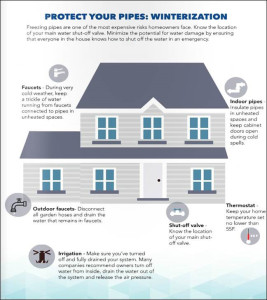 During cold winter weather, water pipes located throughout your home (in you attic, under your floor, and in your walls) can freeze, burst, and you’ll find yourself on the phone with a plumber. It’s not the actual expansion of ice against the inside of the water pipes that causes the pipes to crack and possible burst, but rather the pressure resulting from such expansion, which increases downstream between the ice blockage located in the frozen section of the water pipe and the closed faucet. If cracks are small enough, they might not be visible, but water will still leak through. If larger, however, you could be facing a massive flood, and all of the damage and expense that it entails.
During cold winter weather, water pipes located throughout your home (in you attic, under your floor, and in your walls) can freeze, burst, and you’ll find yourself on the phone with a plumber. It’s not the actual expansion of ice against the inside of the water pipes that causes the pipes to crack and possible burst, but rather the pressure resulting from such expansion, which increases downstream between the ice blockage located in the frozen section of the water pipe and the closed faucet. If cracks are small enough, they might not be visible, but water will still leak through. If larger, however, you could be facing a massive flood, and all of the damage and expense that it entails.
If the frozen section of the water pipe is discovered in time, and adequately thawed (either yourself, or in more serious cases, with the help of a plumber), damage may be averted. The best plan, however, is to protect water pipes from freezing in the first place.
With new homes, the best way to prevent pipes from freezing is to design the home so that pipes are only placed in heated spaces, and out of vulnerable outside walls, crawl spaces and attics, and are properly insulated. With existing homes, however, it is still possible to “winterize” your pipes.
How can this be done?
One way to winterize your home, and to keep the pipes from freezing when the cold weather hits is to hire a licensed contractor to re-route at risk sections to more protected areas. If this is not practical, however, the following are a few freeze prevention techniques that can be done by the homeowner himself, or with the assistance of a plumber:
- Do a thorough check of your house to determine which pipes are most vulnerable to freezing. These will be those that are uninsulated, closed to outside walls and windows, and those running through an unheated space, such as an attic, basement, garage, or crawl space.
- Open all faucets corresponding to vulnerable pipes and let them drip slightly, maintaining a constant drip. This will help provide relieve from the pressure that develops between the ice blockage and the faucet when freezing occurs. Even if the dripping stops, you should still eave the faucet(s) open, since a pipe may now be frozen and pressure relief will still be required.
- Holes and cracks in outside walls and in the foundation of your home, which are located near to any water pipes, should be caulked to keep cold air from reaching the pipes.
- Kitchen and cabinet doors should be kept open to allow warm air to circulate inside and around the pipes.
- Vulnerable and accessible pipes should be fitted with insulation sleeves or wrapping, making sure not to leave gaps exposing the pipe to cold air. Home centers and hardware stores generally carry the necessary materials in the form of fiberglass or foam rubber sleeves. When purchasing a pipe sleeve, ones with extra-thick insulation are worth the extra cost.
- Electric heating tape may be used to keep especially vulnerable pipes from freezing. Such tape, however, must be used with extreme caution and in accordance with all manufacturer’s specifications to avoid the risk of fire.
- Maintain a constant leaving of heating in your house even when no one is home.


